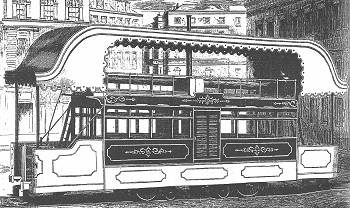 An engraving of the car published at the time of the earliest trials. The flamboyant roof was most likely artistic licence on the engraving and the "maximum traction" wheels may have been a misinterpretation by the engraver.
An engraving of the car published at the time of the earliest trials. The flamboyant roof was most likely artistic licence on the engraving and the "maximum traction" wheels may have been a misinterpretation by the engraver.
|
Grantham's Steam Tramcar
By John Prentice |
Readers may be aware that the steam tram designed by London civil engineer John Grantham in 1871, is regarded as the first steam tram in regular service on a British tramway. But did you know that originally it also had a novel system for fare collection?
 An engraving of the car published at the time of the earliest trials. The flamboyant roof was most likely artistic licence on the engraving and the "maximum traction" wheels may have been a misinterpretation by the engraver.
An engraving of the car published at the time of the earliest trials. The flamboyant roof was most likely artistic licence on the engraving and the "maximum traction" wheels may have been a misinterpretation by the engraver.
What is certain is that it was definitely a double-ended four-wheel open-top car in 1874 photographs and seems to have been built exactly to the drawing included in John Grantham's British patent number 1991 dated 28th July 1871, with the addition of the aforementioned fare collection system described in patent number 3333 dated 9th November 1872.
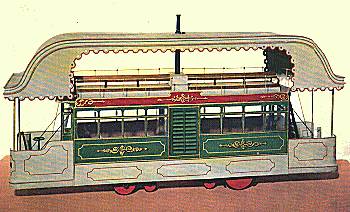 A model owned by the London Science Museum. This is styled on an engraving of the car in the previous picture, which was probably based on some of Grantham's early designs.
A model owned by the London Science Museum. This is styled on an engraving of the car in the previous picture, which was probably based on some of Grantham's early designs.
The tram, constructed during 1872/3, was first shown in steam to the public at a railway arch in Salamanca Street, Lambeth in March 1873. A more full demonstration was undertaken on the night of 25th/26th November 1873 between Victoria and Vauxhall Bridge over the tracks of the London Street Tramways Company in Vauxhall Bridge Road. This trial was not totally successful due to lack of steam power. The car was transferred to a site at West Brompton near the District Railway Works and was demonstrated on a 350 yard track there on 6th May 1874. Sadly on 10th July 1874 John Grantham died in Croydon, aged 66, so never saw the true success of his system.
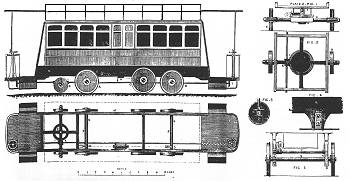 An example of Grantham's early designs, which included a version with steerable wheels which could be raised or lowered for use on asphalt roads. This may have been the origin of the idea that it was a bogie car.
An example of Grantham's early designs, which included a version with steerable wheels which could be raised or lowered for use on asphalt roads. This may have been the origin of the idea that it was a bogie car.
The car was inspected at West Brompton by Edward Ormond and George Stevenson, the Secretary and Engineer of the Wantage Tramway, on 23rd September 1874. On 14th April 1875 it was demonstrated to the Council of the Society of Arts and Grantham was posthumously was awarded the Howard Medal, which had been offered for a locomotive to replace horse traction for trams. Soon after, the car was transferred to the two and a half mile long Wantage line, where for a time it was tested on private tracks. Once Board of Trade permission for steam operation of the tramway was given, it entered regular service from 1st August 1876, thus becoming Britain's first steam tram. At first it was on a free trial, but was purchased from Robert Baxter, who controlled Grantham's Patents, for £250 plus £37.05 for alterations. It continued to run until 1890, although for the last year it had been towed as a trailer with its mechanisms removed. It was sold for 76/- (76 shillings - £3.80) in 1891, seeing further use for a while as a shed near Steventon.
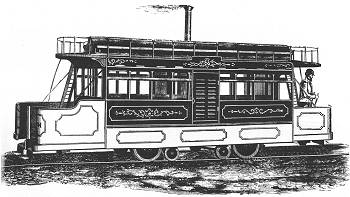 An engraving of the car shown in "The Engineer" in November 1873. This seems to be a modification of the previously published engraving, but with the roof removed and a driver added. The "maximum traction" wheels remain.
An engraving of the car shown in "The Engineer" in November 1873. This seems to be a modification of the previously published engraving, but with the roof removed and a driver added. The "maximum traction" wheels remain.
The mechanism was constructed by Merryweather & Sons of Greenwich, who had experience in steam fire engines. There were two vertical boilers on the Field's system, each 18 inches in diameter and 4 feet 4 inches high. There was a gangway between them so passengers could pass by. Due to the problems with steaming at the Wantage testing where there was a 1 in 47 incline, on the advice of Edward Woods (John Grantham's associate) these boilers were replaced by a single larger vertical boiler from Shand, Mason & Co. The cylinders were 4 inch diameter and 10 inch stroke, driving one axle only. The wheels were originally 30 inch diameter set at 10 feet wheelbase, but these may have been replaced later by 24 inch ones. To ease cornering, one of wheels on the non-driven axle was fitted loose on a sleeve, allowing the wheels to rotate at different speeds, and the original patent suggests that the wheels on one side were flangeless. Exhaust steam passed via a series of coiled condenser tubes on the roof before going into the water tanks, finally venting to the funnel.
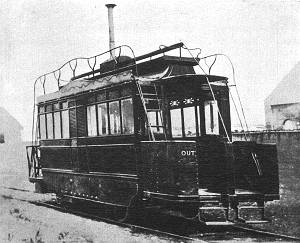 Grantham's steam tram seen at West Brompton during May 1874. The sign for "OUT" can be seen on the end dash. The steps are in the lowered position.
Grantham's steam tram seen at West Brompton during May 1874. The sign for "OUT" can be seen on the end dash. The steps are in the lowered position.
The tram body was built by the Oldbury Railway Carriage & Wagon Works Co. Ltd. The car was 27 feet 3 inches long and 6 feet 6 inches wide, weighed 6.5 tons including fuel and water. It carried 44 passengers on longitudinal seats, 20 inside, 24 on top, but could hold 60 or more including standees. The normal running speed was 10 mph but it was known to go faster, maybe as much as 20 mph. At Wantage the car ran 8 return trips per day (40 miles) and consumed on average 220 pounds of coke.
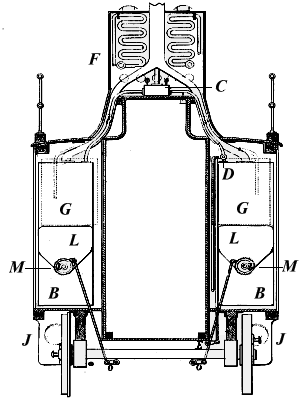 A cross section through the centre of the car from British patent number 1991 of 1871.
A cross section through the centre of the car from British patent number 1991 of 1871.
The driver had removable controls for the steam cock, the reverser and the furnaces, and originally included a foot operated brake, later replaced by a more conventional hand brake. They would be placed by the driver at the leading end of the car and were located just behind the dash plates. By means of rods, the furnace controls turned spirals which forced coke from hoppers into each firebox.
At the Board of Trade's request to comply with their regulations mostly to do with braking and speed control, a number of changes were made to the car at the Avonside Engine Company of Bristol in early 1877.
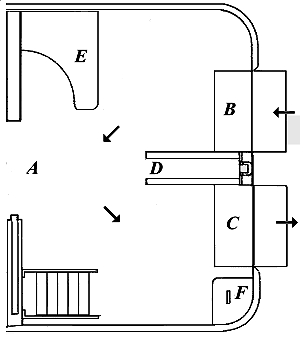 This is an extract from British patent number 3333 of 1872. A is the rear platform. B and C are respectively the entrance and exit steps in the "down" position. D marks the gates in the open position, thus forming the barrier between boarding and alighting passengers. E is the table where the conductor collects fares and issues tickets. F is the "used tickets" box.
This is an extract from British patent number 3333 of 1872. A is the rear platform. B and C are respectively the entrance and exit steps in the "down" position. D marks the gates in the open position, thus forming the barrier between boarding and alighting passengers. E is the table where the conductor collects fares and issues tickets. F is the "used tickets" box.
As mentioned at the top of this article, an outstanding feature was the fare collection. To describe it I can do no better than to quote John Grantham's own words from his 1872 patent:-
My invention is most applicable to my Patent steam tramway carriage, though it may be used for horse carriages. I begin by making the platform at each end longer than usual, and I make the entrances at the ends of these platforms and not on the sides as at present. The steps leading to these platforms are long enough to admit of a separate entrance and exit at each end. To these are applied two gates, which open inwards and thus form a partial barrier between the passengers entering and those leaving. On the side where they enter a man stands with a table, where he receives money and gives tickets; these tickets being so coloured or marked as to show where the passengers entered, and when leaving he passes on the other side where is a box to receive the tickets. To this box the inspector at the terminus has access, and the number of tickets thus collected is a check on the conductor who gives them out. These operations are performed at the end, which is for the time the back, but when going in the other direction the gates above described are closed and the steps are folded up, so that no one can gain admission.
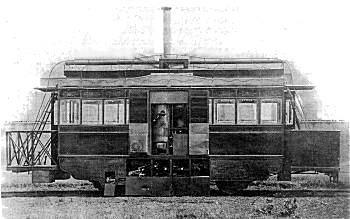 Taken at West Brompton during May 1874, this view shows the car with the side panels open to reveal the original boilers and the cylinders. The dash plates at the left hand end have also been removed. Compare this view with the patent drawing below.
Taken at West Brompton during May 1874, this view shows the car with the side panels open to reveal the original boilers and the cylinders. The dash plates at the left hand end have also been removed. Compare this view with the patent drawing below.
On the end dashes to either side of the steps was painted "OUT" and "IN". Since the model and the etching from which it derived both show these features, we can assume that the fare collection system was in place for the London trials. It was mentioned in a report in The Times on 29th March 1873, following the Salamanca Street demonstration. It was certainly still there at West Brompton, the "OUT" can be seen in the picture. Since Wantage had suitable tickets, it is likely that the system was put to public use there in the early days of that tramway.
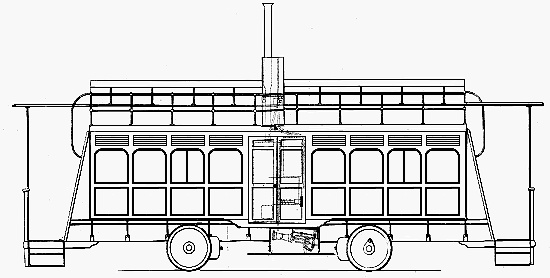
Fare systems where the passengers pass by a conductor's table on entry and then use a different exit can still be seen today on a few tramways. John Grantham was clearly well ahead of his time with his ideas both for steam trams and fare collection.